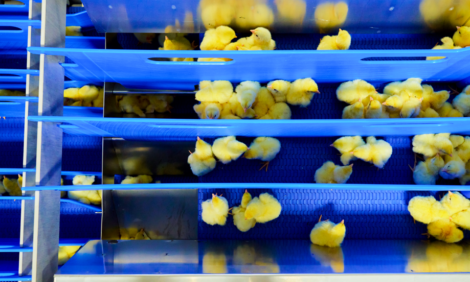



Spinal Abscesses in Male Broiler Breeders
The pathogenesis of vertebral osteoarthritis (also known as spinal abscesses) in male broiler breeders caused by Enterococcus cecorum was investigated by M. Martin and colleagues at North Carolina State University, and described in a report for the US Poultry & Egg Association.Enterococcal vertebral osteoarthritis (EVOA) is an emerging disease of male broiler and broiler breeder chickens. The report's authors have observed multiple broiler and male broiler breeder flocks from several commercial integrators in North Carolina with EVOA, causing significant mortality and morbidity. There is evidence of EVOA affecting poultry across North America and the European Union. The bacterium, Enterococcus cecorum has been recovered in heavy, pure cultures from almost all of the spinal abscesses in the flocks observed in North Carolina. Sporadic spinal abscesses similar to EVOA in poultry caused by other bacteria, including Escherichia coli and Staphylococcus aureus, have been previously described. However, outbreaks of spinal abscesses in broiler breeder flocks associated with E. cecorum had not been documented.
The principal objective of this study was to determine the pathogenesis of EVOA in male broiler breeder chickens. Specific objectives were to:
- reproduce spinal abscesses caused by E. cecorum experimentally under controlled laboratory conditions
- re-isolate E. cecorum from infected birds
- determine the development of infection and disease in broiler breeders following different natural (oral) and parenteral (air sac, haematogenous) routes of exposure, and
- determine the role that stress may have in the occurrence of infection, lesions, and disease.
The study was designed to determine if a causative role in EVOA could be established for E. cecorum.
Martin and colleagues report that they were able to reproduce spinal abscesses caused by E. cecorum experimentally under controlled laboratory settings.
In challenged birds, they found one out of 34 birds challenged intravenously and two out of 33 birds challenged orally had developed spinal abscesses.
From the birds that developed spinal abscesses in the study, the researchers were able to re-isolate E. cecorum from the spinal lesions.
Based on the results, it appeared that oral challenge was the most likely route of exposure associated with the development of spinal abscesses followed by intravenous challenge.
The researchers were unable to produce the disease by intra-air sac challenge. They were unable to increase the incidence of spinal abscesses by chemically inducing stress with dexamethasone. If stress predisposes birds to disease, it may be more associated with gut-specific stress.
Martin and colleagues conclude that the study suggests that oral challenge is the most likely route of infection. They say this has allowed them to key specifically in on gut health and its relationship to EVOA in clinical cases. EVOA flocks have subsequently been identified nationally as having gut stressors such as severe feed restriction, coccidiosis, and attaching/effacing bacteria in the intestinal tract.
Also, the success of the study has allowed the North Carolina group to develop a study design to potentially improve on our ability to re-create the disease. By developing a better research model, therapeutic and preventative measures can be more readily studied for the control of EVOA.
April 2010









